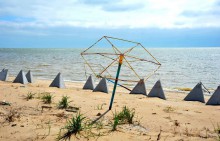After finishing the construction of the Crimean/Kerch Bridge, Russia proceeded with a proxy blockade of the Sea of Azov and its ports. The bridge does not allow large ships to pass through anymore. According to June 2018 statistics, over 144 container ships stopped visiting the seaports of Mariupol and Berdiansk, unable to pass under the bridge. There are also raids by Russia’s FSB and Coast Guard gunboats that stop ships en route to Ukrainian seaports.
For more than three months, Russia’s Coast Guard ships have been meticulously inspecting vessels headed for Azov seaports or on the way back. One might say that their inspections were too meticulous, forcing the ships under inspection to waste dozens of hours, which costs shipowners large sums.
Andrii KLYMENKO, Chairman of the Board, Foreign Affair Maidan Foundation, said: “First, these ships have to wait for permission to pass under the Kerch Bridge and reach the Sea of Azov. All have to wait to let an Azov-Black Sea convoy pass [for example]. When on the Sea of Azov, any vessel en route to a seaport or on the way back can be stopped [and inspected] by a [Russian] Coast Guard gunboat.”
Such inspections are taking increasingly longer periods. According to Mr. Klymenko, in July, they averaged from two to four hours, then increased to almost 33 hours toward the end of the month. The worst delay on record is 55 hours. It involved 62 8-15-ton vessels en route to Azov seaports. The cost of 24 hours of delay is 4-5 thousand USD. This discourages the shipowners and they can’t blame the consignor. When their ships are idle en route, they must absorb the full costs of untimely deliveries.
Russia explained that all this was part of their security precautions while conducting naval exercises. They promised that this would stop before the fall.
There are other explanations, however, including the possibility that Russia is doing this in response to Ukraine arresting the Russian dredger ship Nord registered in Crimea (March 25). Ukraine now has only two seaports, Mariupol and Berdiansk, on the Sea of Azov, and the Black Sea ports of Odesa, Chornomorskyi, Yuzhnyi, Ochakivskyi, and Skadovskyi, including the ones in Kherson and Mykolaiv which have access to the Black Sea through channels.
The problem is that moving shipments from Azov to the Black Sea means that you’ll have to add a couple of bucks per ton of cargo, damaging the manufacturer’s reputation. However, the costly option is on the agenda. There is also the Ilyich Metallurgical Complex of Mariupol [“Ilyich” – from “Vladimir Ilyich Lenin.” – Ed.], now part of Metinvest Holding Co. They had to move cast iron shipments to Black Sea ports.
Logistics actually remain the same, considering that the shipowners appear prepared to bear additional costs, without increasing freight rates, lest they lose regular customers, in view of the market competition. Some also see the sanctions imposed on Russia as temporary. They believe that the situation may well change “for the better” this fall. Even so, there are no guarantees that this “truce” will last long, just as there is no telling what Russia will do next. Business requires stability and each shipowner must be sure when it’s profitable to take the next cargo.
Volodymyr OMELIAN, Minister of Infrastructure of Ukraine, feels sure that Russia is trying to rock the boat in the Azov region: “We’re in contact with our partners, working out measures to help impose similar sanctions on the Black Sea ports that are currently under Russia’s control.”
The Ukrainian Seaport Oversight Administration is keeping track of all ships stopped and inspected by Russia, and relays the data to the Ministry of Infrastructure and the Ministry of Foreign Affairs of Ukraine. Official Kyiv has contacted the OSCE, asking to task the Supervisory Board with keeping track of Russia’s wrongdoings on both terra firma and within Ukraine’s territorial waters. Costs are being assessed to file damage claims vs. Russia in international courts, including damages caused by the Crimean/Kerch Bridge, considering its height that bans passage for larger vessels.
There are certain aspects to Russia’s Coast Guard gunboats stopping and inspecting ships. Officials of the State Border Guard Service of Ukraine say such inspections are formally possible under the 2004 Agreement on the Sea of Azov, considering that the sea is an inland body of water and that there are no territorial waters per se. Ukrainian Coast Guard ships would be within their right to stop and inspect ships en route to Russia’s seaports of Azov, Rostov-on-Don, etc., but they keep their distance, apparently careful not to aggravate the situation.
In view of this, the legal status of the Sea of Azov has to be revised. There is a bill filed with the Verkhovna Rada, entitled “On the Denunciation of the Treaty on Cooperation in the Usage of the Sea of Azov and Kerch Strait, signed by Ukraine and the Russian Federation.”
InterLegal’s partner Artur Nitsevych says ships can’t be stopped and inspected while in an international strait, that this is against international law. Kerch Strait is subject to full freedom of navigation for civilian ships and warships of Ukraine and Russia. Foreign warships are allowed entry only with the knowledge and consent of the contracting parties. Experts further recommend that the shipowners keep their distance from Lotsman-Krym, the pilot company currently in Russia-annexed Crimea, formerly a Ukrainian government-run company, that provides most piloting services.
Lawsuits will take time, of course. Meanwhile, efforts should be taken to upgrade the Ukrainian Navy. Currently, it is unable to defend Ukraine’s interests in the Sea of Azov. A time-consuming process, but time is money and it is a matter of national security for Ukraine.








